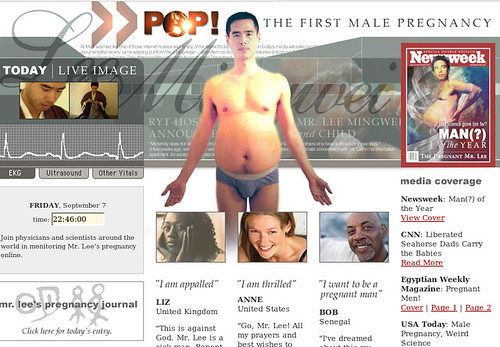
In 2008, much sensation ensued at the news of Thomas Beatie, the world’s first pregnant male. A transgender and legally male, Thomas Beatie became the first male to conceive, having kept his female reproductive organs in the hopes of one day bearing children. When his wife was found to be infertile, Beatie decided to have the child (and two more) himself.                         



Thomas Beatie, however, is not the only pregnant male; Lee Mingwei is, too. According to the website malepregnancy.com, created in 2001, Lee Mingwei is not a transgender but male by birth who has the ability to carry children in his abdomen area. In fact, however, this entire website, with such detailed information and an entire range of evidence to support the claim of a pregnant Lee, including a documentary featuring the pregnant male is an art project conceived by artists Lee Mingwei and Virgil Wong.
It can be assumed that the basis of this project is to challenge the notion of “What does it mean to be female? What does it mean to be male?”, as Lee states several times throughout the excerpt of the featured documentary. Lee is countering the societal claims of a woman as the childbearer, challenging the idea that it is the woman’s duty to give birth and that men can do it, too. It leads one to ponder the issues presented by societal norms of gender roles, obligations, and expectations and the pressures of responding and reacting to these confined categories.
One could applaud Lee and Wong for undertaking such a controversial project that forces the viewer to reflect on these issues, yet, in watching the documentary and going through the site, I couldn’t help but think that this project, as much as it wants to challenge the viewer’s notion of norms, actually reinforces it, as well. For instance, consider the project in its simplest terms: a pregnant male. Though this sensation does shake the foundations of long accepted biological and sociological understanding, it also presents another contentious layer– that of the dominant, all capable male. In taking a strictly female ability and transferring it to the powers of a man, it undermines the woman’s uniqueness and own social importance, especially if in social terms, the ability to bear children is the defining difference between a male and a female. It lends the idea that women are no longer necessary for life and that men can have the total dominance and power not only in leading life, but creating it, as well.
In this way, Lee strengthens our ideas of what is socially acceptable by putting such an emphasis on the sensationalism of such a phenomena: a pregnant male. In constantly highlighting the uniqueness of the situation, it reminds us yet again that of course women are the childbearers. This point is especially discernible when, during a checkup with the doctor, he jokes, “Do women feel like this, too? Or is it because I’m a man?”, which yet again focuses the attention on the natural capabilities of the woman as childbearer– i.e. because woman is made by nature to carry a child, she is also made by nature to endure the hardships that go with it; thus, should a man be placed in that same position, because he lacks the natural capabilities to adjust to a pregnant lifestyle, he would have a hard time; as such, it is only natural that women are those who bear children.
As I am exposed to more things that attempt to be controversial or present things out of the norm, I keep realizing that the effect has two sides: one is the instant, reactionary effect whereupon the viewer at the moment of the encounter is shocked, awed, inspired, repulsed, etc and does come to question (although perhaps to a small degree) what we consider to be the norm; the second is the same reactionary effect of shock, awe, inspiration, repulsion, etc that does the opposite– it reinforces and strengthens our existing notions of the normal and acceptable. The latter reaction usually follows the former.
Why is this? Why is it that a work of art that is “controversial” actually reinforces our current ideals than revolutionizes or shakes the foundations of our perception of the “right?” Maybe it’s because so much emphasis is put on the uniqueness of the situation, so much sensationalism exudes from the controversial topic itself that the artwork becomes instead an embodiment of the “surreal, different, unacceptable”. Because of the deeply infused contentious nature of the subject, the art does not place itself in the world of the “normal” as being “normal” but places itself in the world of the “normal” as being “abnormal” and therefore “socially unacceptable”. But then this hypothesis poses the counter question of whether presenting something out of the norm as normal undermines its abnormality and thus, its importance in generating discussion and change. Personally, I don’t think that the latter would pose too many problems. It can go either way: either convince the viewer of the normality of the abnormal situation and change their views on what “normal” is or incur a reaction similar to that of the first hypothesis, where we perceive as being portrayed as normal yet we know it is not and thus continue to support our existing notions of the norms.
—–
Gabby Park is a triple concentrator in Communication Studies, French, and History of Art who also thinks too much while watching movies and consuming other forms of media and art.



Leave a Reply
Be the First to Comment!